5G Features
5G – The India story
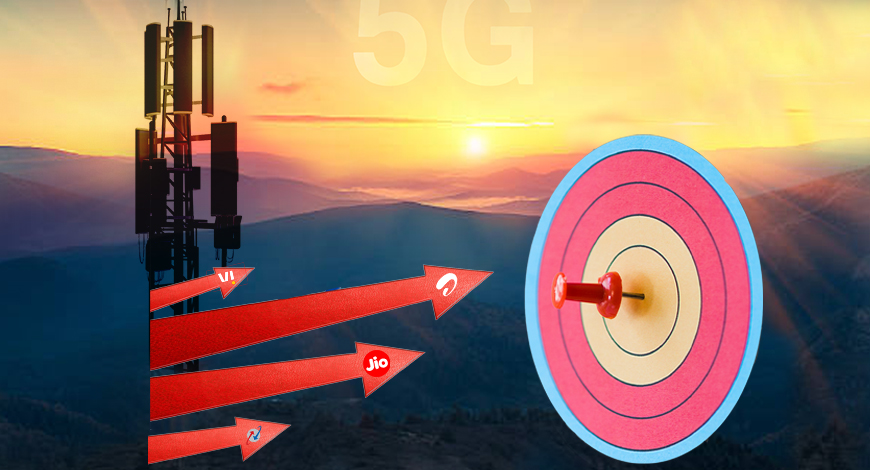
With the recent capital infusion in BSNL, and the three telcos having seen higher revenues and ARPUs in FY23, Indian telecom sector seems to be on the cusp of a turnaround.
India has implemented one of the fastest rollouts of 5G services in the world. Within 8 months of the launch, Reliance Jio and Bharti Airtel have provided coverage in 700 districts, with 200,000 sites installed, with one site installed per minute. 5G network has been rolled out in all 28 states and 8 UTs now. No mean feat indeed!
A Telecom Kranti in the words of Union Minister for Communications, Railways and Electronics & IT, Ashwini Vaishnaw. Developed countries like USA are showing interest in Indian 4G/5G technology stack. The minister, while launching the 200000th 5G site at Gangotri in May 2023, also said that to lead in the 6G technology development, India has over 100 patents in 6G technology, which shows the prowess of the talented engineers and innovators of the country.
This received international acclaim too. “India, when it comes to 5G technology, is moving at absolute warp speed. I think India has experienced some of the fastest large-scale deployment of 5G infrastructure anywhere in the world and continues to do so. That’s an amazing representation of India’s inventiveness and ability to adapt and adopt new technologies rapidly. The speed, with which India is adopting and rolling out 5G technology, I think augurs very well, for India being able to unlock tremendous economic and technology benefit from it,” said Robert Le Busque, regional vice president of Asia-Pacific, Verizon Global Enterprise.
“India is likely to overtake America in 5G rollout by the year-end,” said Börje Ekholm, CEO, Ericsson. The US ambassador to India, Eric Garcetti, expressed confidence and added, “India, with its vast population, its thriving digital economy, the use of technology that in some ways is leapfrogging other nations around the world, is poised to leverage the transformative power of 5G and 6G… to catapult itself to the forefront of the digital revolution.” Accolades abound.
The two telcos seem to be in a frenzy. Jio plans to provide all-India 5G coverage by December, with Airtel aiming for blanket availability by March next year.
Bharti Airtel is rolling out non-standalone 5G (NSA-5G), wherein the company will use 3500MHz band for downlink and L-1800 for uplink. The uplink on L-1800 band helps Bharti coverage by additional 100–300mts, which will improve experience versus otherwise only 3500MHz-based 5G network. Bharti will be mounting largely integrated radio (radio and antenna), while 4G BTS will be used with additional 5G slot. NSA-5G will use the core of 4G. For backhaul, Bharti will require to strengthen its fiber footprint, but it will be less pressed due to E-band (71–76/81–86GHz) allocation. E-band can provide a microwave throughput of up to 10 Gbps, which can help maintain reasonable quality of 5G services with one-hope fiberization.
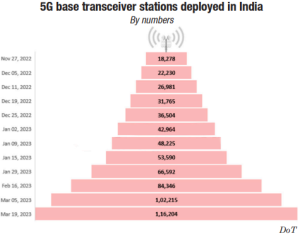
RJio is rolling out standalone 5G (SA-5G), wherein RJio will use a combination of 3500MHz/700MHz with carrier aggregation. This will help RJio provide superior experience deep into the market due to sub-GHz spectrum. RJio will also need to invest in separate core for 5G. RJio is relatively better placed with strong fiber network for backhaul versus Bharti.
Bharti Airtel and RJio have committed large CapEx outflow for 5G rollout over the next few years. Bharti has guided for total India CapEx of ₹750 billion for the next three years, wherein in FY23 and FY24, CapEx will be relatively high, and it will start tapering FY25 onwards. RJio has announced total 5G investments of ₹2000 billion, which includes ₹900 billion toward spectrum, ₹600–700 billion toward network rollout and the remaining for ecosystem development.
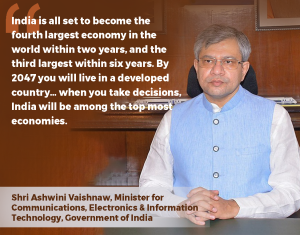
Vodafone Idea and BSNL have yet to deploy their respective 5G networks. While Vi has been trying to raise funds from the market for more than two years without success, BSNL has recently been sanctioned a revival package of ₹89,047 crore, its third; its first was in October 2019, when it was awarded ₹69,000 crore and the second in July 2022 was a bigger package of ₹1.64 lakh crore. It is expected that both the telcos are putting their house in order, and India may well continue to have four service providers. How these two will manage to keep their heads above water, only time will tell.
While India is expected to have pan-India 5G coverage by March 2024, “right now the telecom industry is ahead of the rest of the ecosystem,” says Gopal Vittal, Chief Executive Officer of Bharti Airtel and South Asia. He elaborates, “The rest of the ecosystem across devices, across applications, content, all of that needs to change and we hope that over the next coming years, this ecosystem will flourish. 5G is a spy around which more application need to come.”
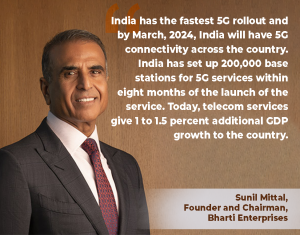
Many unresolved issues threaten to create havoc with the telcos that already have over-stretched balance sheets, stressed with huge debts, poor realizations because of low prices, and low ARPUs. The decision to auction or not to auction satellite spectrum is yet to be taken. While the millimeter-wave (mmWave) spectrum has been auctioned, and is already with telcos, it has yet to see application around home and enterprise usage in India. Right-of-way continues to be a challenge in most states.
While tech companies want spectrum directly from the government for setting up captive networks, the stakes are as high as ₹75,000–₹90,000 crore for the telcos, for that is what they expect to generate once private networks deployment starts fully in the next few years and India is able to find its use cases for enterprise.
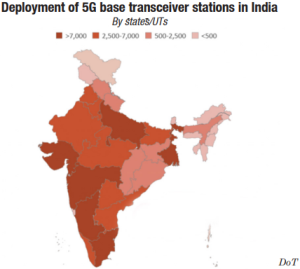
To add to this, the timeline for 6G in the nation is set for 2030. Bharat 6G vision document aims to facilitate finance R&D, design, and development of 6G technologies by Indian startups, research bodies, and universities to enable India to become a leading global supplier of IP, products, and solutions for affordable 6G telecom solutions. Phase 1 (2023 to 2025) is expected to explore ideas, risky pathways, and proof-of-concept tests. Phase 2 (2026 to 2030) is expected to develop ideas, establish use cases and benefits, create IP, and set up test beds for commercialization.
This new technology, however, will truly be a step up. 6G will likely support data rates of 1 terabit in a second, meaning that the use cases will expand to ideas such as holograms and AR products, which is truly revolutionary.
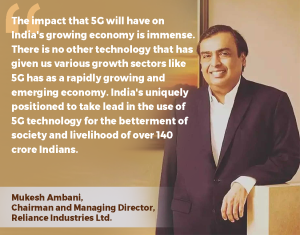
Not only this, but the technology is also the first to allow for connection between terrestrial and non-terrestrial networking elements, which will enable a device to work between multiple technologies, bringing with it a revolutionary change and connecting millions, if not billions, of machines.
With the current global economy best described as slow, uncertain, challenging, difficult, volatile, and unpredictable, the Indian telecom industry is cautiously optimistic of where it is headed.















You must be logged in to post a comment Login